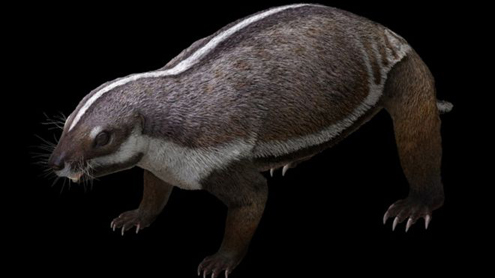What Makes “Crazy Beast” So Crazy
The Very Strange Adalatherium hui
This week, has seen the publication in the journal “Nature” of a scientific paper describing a new species of bizarre mammal from the Late Cretaceous of Madagascar. Named Adalatherium (A. hui), this cat-sized animal shared its island home with a variety of predators such as abelisaurid dinosaurs, crocodilians and snakes. At an estimated three kilograms, Adalatherium was no giant, but the fossilised remains, which represent a near complete skeleton of an individual, indicate that this mammal was not yet fully mature when it died and as such, it is one of the largest members of the crown group of mammals described from Upper Cretaceous material.
Adalatherium hui
A Life Reconstruction of Adalatherium (A. hui)
Picture credit: Reuters
Madagascar became isolated from the rest of Gondwana around 88 million years ago. Animals on the island were effectively marooned and many pursued a different evolutionary route compared to related forms on the rest of the super-continent. Classified as a member of the Gondwanatheria, an extinct group of mammaliaforms confined to the southern hemisphere and up until now, only known from isolated teeth and fragmentary bones, the Adalatherium lineage developed an unusual and unique set of characteristics never seen before in a tetrapod.
“Crazy Beast”
The backbone has more vertebrae than any other Mesozoic mammal and one of its rear leg bones (tibia) was bowed. How this animal moved around is a bit of a mystery, but the authors of the scientific paper suggest that this animal lived in burrows (fossorial). The snout shows a mixture of primitive and very advanced anatomical traits. Adalatherium had more foraminia, small holes in the nasal cavity that served as passageways for nerves and blood vessels, than any other mammal extinct or living today.
The snout was probably extremely sensitive and covered in whiskers, they may have helped it find its way about underground. One foramen (hole for nerves or blood vessels), at the top of the snout has no know parallel with any other mammal.
These strange characteristics inspired the researchers to name this animal “crazy beast” from the local Malagasy and from the Greek.
The Preserved Skeleton of Adalatherium and Accompanying Line Drawing

Picture credit: Krause et al.
Adalatherium hui – Bending and Breaking a Lot of Rules
Corresponding author, Dr David Krause (Denver Museum of Nature and Science), commented:
“Knowing what we know about the skeletal anatomy of all living and extinct mammals, it is difficult to imagine that a mammal like Adalatherium hui could have evolved, it bends and even breaks a lot of rules.”
Dr Krause is no stranger to bizarre prehistoric animals from Madagascar. In 2008, Everything Dinosaur wrote a blog post about the “frog from Hell”, a research team led by Dr Krause had discovered the fossilised remains of a giant frog that inhabited the Late Cretaceous of Madagascar.
To read more about this: Beelzebufo ampinga – a frog that could jump continents!
The scientific paper: “Skeleton of a Cretaceous mammal from Madagascar reflects long-term insularity” by David W. Krause, Simone Hoffmann, Yaoming Hu, John R. Wible, Guillermo W. Rougier, E. Christopher Kirk, Joseph R. Groenke, Raymond R. Rogers, James B. Rossie, Julia A. Schultz, Alistair R. Evans, Wighart von Koenigswald and Lydia J. Rahantarisoa published in the journal Nature.
Visit Everything Dinosaur’s website: Everything Dinosaur.


